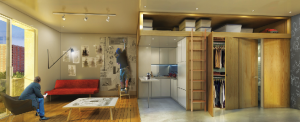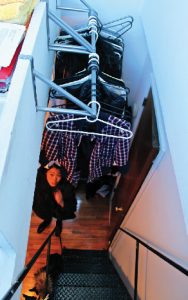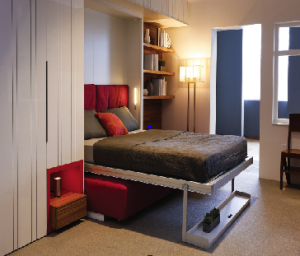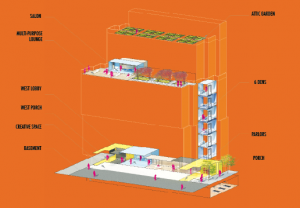Dorm Like Micro-apartments Could Become the City’s Future
Since Nicole Chu moved into her 200-square-foot, $1,675-a-month West Village studio in August, small spaces have forced her to get creative. She uses a Pilate’s mat as her dining area. She places a ceramic water bowl atop her radiator, in lieu of a humidifier. And between the ceiling and an iron staircase—which leads to a lofted storage area—she hangs her wardrobe.
But no matter how inventive Chu gets with her studio, she still wishes her building offered more amenities—she welcomes a cafeteria or common areas, for instance—to compensate for the cramped size.

“They could be like dorms, but maybe cheaper,” Chu, a 20-year-old sophomore at Lang, from Taipei, Taiwan, told the Free Press. “It would attract many young people who go to class nearby and don’t need much space.”
******
If Mayor Bloomberg and a group of New York developers get their way, the city’s housing market will soon feature apartments that are small—“micro-small”—but can squeeze more paying residents in its landscape.
By September 2015, what is now a city-owned parking lot at 335 E. 27th St., near First Avenue, will be a 55-unit micro-apartment complex. Brooklyn-based firm nArchitects drafted the proposed building’s blueprint. The suites will range from a mere 250 to 375 square feet. Amenities will include lounges, laundry rooms and fitness centers.
“Home is not bound to an apartment,” nArchitects firm partner Mimi Hoang told the Free Press. “Hopefully our design will set the precedent.”
Many of the communal spaces offered in the design often exist in most university dorms.
“It is sort of like a glorified dorm,” Joel Towers, Parsons dean and founding partner of Manhattan-based firm SR+T Architects, said of the upcoming E. 27th Street micro-apartment complex. “It is critical in urban environments that we experiment with projects like this.”

The least expensive units—11 of the complex’s 55 suites—will likely cost between $11,000 and $22,000 a year, according to the New York City Department of Housing Preservation and Development. They will market to those making less than 80 percent of Kips Bay’s median income. The average area resident earns just over $87,000, according to 2009 statistics from City-Data.com.
At The New School, most students fall below that income line and, in turn, may qualify to live in these spaces. But annual costs at the East Side complex will seldom differ from those in university housing. The average New School student living in a two-person dormitory pays just under $15,000 a year, according to Assistant Vice President for Housing and Residence Life Rob Lutomski.
“There are some major differences between university student [housing] and independent apartments,” said Lutomski. “Student residences provide a close-knit, student-based community that can’t be replicated by an apartment.”
Current zoning code does not permit micro-apartment projects. Any residential structure built after 1987 must exceed a mean unit size of 400 square feet. Until city planners state otherwise—which would not happen until at least 2016—the Kips Bay complex will be the rule’s lone exception.
Mayor Michael Bloomberg wants the city to update its current square-footage minimums, which he has called outdated.
“New York’s ability to adapt with changing times is what made us the world’s greatest city,” Bloomberg said in a January 22 press statement. “And it’s going to be what keeps us strong in the 21st century.”
Hoping to make room for residents amidst housing shortages, Boston, Chicago and Seattle developers have begun their own micro-apartment pilot programs. And in San Francisco this past November, planners amended their city’s zoning codes, allowing developers to make 220-square-foot studios. The decision has piqued the ire of tenant rights advocates, many of whom do not consider smaller apartments effective—or even inhabitable—solutions for city housing shortages.
“If we made cages, we can house more people as well,” said Tommi Avicolli-Mecca, the director of counseling at the San Francisco-based Housing Rights Committee. “I don’t care how many windows or rooftop gardens these units have. Nothing substitutes real space.”
Some critics also feel that if micro-apartment development is inevitable then planners should at least cater more units to lower-income residents.

“These units are priced out of range for people who need them most,” Avicolli-Mecca said.
“Anyone who thinks the working class can afford moving into these, is living in fairy tales.”
Uptown, the Museum of the City of New York takes another look at micro-apartment design. Visitors to “Making Room: New Models for Housing New Yorkers”—an exhibit that opened on January 23 and runs until September 15—can experience a real-life sense of micro-apartment life. Museum goers can walk inside a 325-square-foot sample unit and experiment with furniture items like Murphy beds, fold-down tables and stackable chairs. The mock-up also features a bar and a sliding television.
“There is a mismatch between who is living in New York now and what city real estate currently offers,” said exhibit co-curator Donald Albrecht. “Micro-apartments can show how architecture and interior design can accommodate social change.”
*****
After spending six months in a micro-apartment, Chu says she would rather live in a larger space. She hopes to find a larger, less expensive flat in one of the outer boroughs. But life in a small apartment has taught her some lessons that she hopes to apply at her future residences.
“I have learned how to manage space and money better,” said Chu. “I think twice about buying things I don’t need.”
And while she cannot see herself living in another micro-apartment, she knows plenty of people who would enjoy moving into one.
“More of today’s New Yorkers are independent, work-driven and on the go,” Chu added. “There’s definitely a market for tiny spaces.”
But if micro-apartment complexes gain citywide traction, there would be no guarantee of dorm-like perks in all the buildings. The influence of the E. 27th Street building could either inspire a new wave of city housing projects or wither once the hype ends.









Leave a Reply